

Fake News About Retreating Glaciers and Snowcover.
Causes of Glacial Melting. Iceland. Greenland. Glaciers in the Himalayas and Asia. Kilimanjaro. Glaciers in the US. Glaciers in Canada. Glaciers in Scotland/UK. Glaciers in Europe. Glaciers in Russia. Glaciers in South America. Munich Climate Conference 2019. Antifa thugs outside Munich Conference Center.
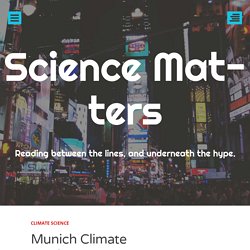
Thanks to Andreas Müller for writing at his blog hintermbusch on four key presentations at the EIKE Climate Conference on Nov. 23, 2019. As many have read, eco-terrorists forced the sessions out of the scheduled venue, but the gatherings went on elsewhere. So much for dialogue in search of scientific truth. Here are some excerpts in italics with my bolds to encourage readers to read his informative report. (link in red above). In this blog post, I summarize these lectures and add links to the video clips for you to follow the lectures on your own and in full detail (Only the first talk was in German and is not easily accessible for most of the international public). Christian Schlüchter, Switzerland Prof. em. One of the most intuitive finds of Schlüchter’s is this huge tree trunk, found at a glacier tongue (see the most beautiful glacier snout behind!). Warm periods: more life Warm periods: more civilization Nicola Scafetta, Italy. Peer-Reviewed Ignorance And Hearsay. When in a pinch, Zeke Hausfather is the go-to-man for climate disinformation.
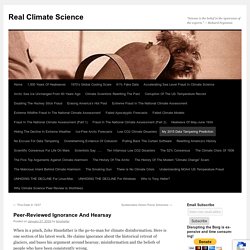
Here is one section of his latest work. He claims ignorance about the historical retreat of glaciers, and bases his argument around hearsay, misinformation and the beliefs of people who have been consistently wrong. APS Physics | FPS | Climate Change: Robust Evidence of Causes and Impacts He could have gone to the Glacier Bay National Park website, and found out that Alaska’s largest glacier retreated 45 miles from 1750 to 1880. Glacier Bay’s Glacial History – Glacier Bay National Park & Preserve (U.S. But Glacier Bay hardly retreated at all over the last 50 years. He could have gone to the USGS web site and found out that Glacier National Park has been retreating since 1850. History of Glaciers in Glacier National Park Experts predicted Glacier National Park would be ice free by 1948. 29 Dec 1923, Page 5 – at Newspapers.com Greenland’s Ice Island Alarm. Climate shock: 90 percent of the world’s glaciers are GROWING - Principia Scientific International.
Published on Written by iceagenow.info A new NASA study, released on Friday, admits that ice is accumulating in Antarctica.
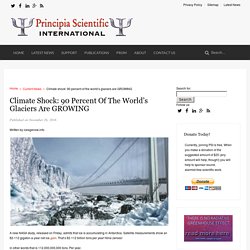
Satellite measurements show an 82-112 gigaton-a-year net ice gain. That’s 82-112 billion tons per year! Climate Craziness of the Week: ‘feminist glaciology’ in the climate change context. I’ll probably be labeled a misogynist pig for even bringing this paper to the attention of our readers, but there are just some things that just deserve to be called “crazy”.
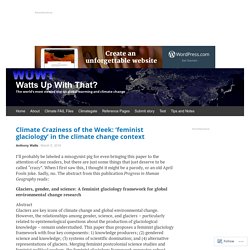
When I first saw this, I thought it might be a parody, or an old April Fools joke. Sadly, no. The abstract from this publication Progress in Human Geography reads: Glaciers, gender, and science: A feminist glaciology framework for global environmental change research Abstract Glaciers are key icons of climate change and global environmental change. Source: h/t to Richard Saumarez Like me, you are probably wondering what a “feminist glaciology framework” is Through a review and synthesis of a multi-disciplinary and wide-ranging literature on human-ice relations, this paper proposes a feminist glaciology framework to analyze human-glacier dynamics, glacier narratives and discourse, and claims to credibility and authority of glaciological knowledge through the lens of feminist studies.
Oh. Like this: Like Loading... Timelapse of Earth's Glaciers: Changing Perspective of The Past 50 Years. Published on December 20, 2019 Written by Michelle Starr New timelapse videos from satellites that have been monitoring Earth for decades have revealed the shocking reality of ice melting at accelerated speeds all over our planet.
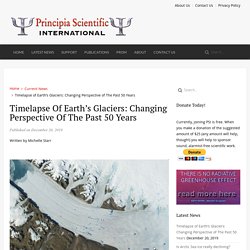
The series focuses on glaciers and ice sheets in Alaska, Greenland and Antarctica, showing how, over the decades, most of the ice is retreating annually and not growing back. “I think observational glaciology in terms of remote sensing is a very data-rich field now, compared to 1972, when you had a few images,” says glaciologist Mark Fahnestock of the University of Alaska Fairbanks. “So we are beginning to get a historical record of the speeds of glaciers, and so we can watch how rapidly that surface is lowering as things speed up, or where it’s thickening.” Claim: Glaciers melt faster than ever. This is the Rhone Glacier in June 2014.
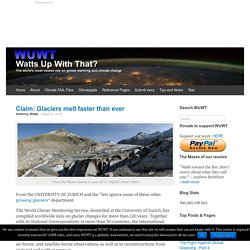
CREDIT Simon Oberli From the UNIVERSITY OF ZURICH and the “lets ignore some of these other growing glaciers” department The World Glacier Monitoring Service, domiciled at the University of Zurich, has compiled worldwide data on glacier changes for more than 120 years. Together with its National Correspondents in more than 30 countries, the international service just published a new comprehensive analysis of global glacier changes in the Journal of Glaciology. Jakoshavn Glacier Melting 1850-1903. New paper finds glaciers have been melting naturally at the same rate since 1850, no acceleration predicted.
A paper published today in The Cryosphere finds global glaciers melted at the same rate in the first half of the 20th century as in the second half.
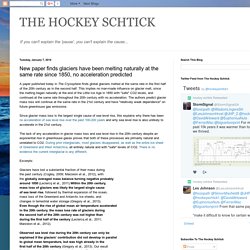
This implies no man-made influence on glacier melt, since the melting began naturally at the end of the Little Ice Age in 1850 with "safe" CO2 levels, and continued at the same rate throughout the 20th century with no acceleration. The authors predict glacier mass loss will continue at the same rate in the 21st century and have "relatively weak dependence" on future greenhouse gas emissions.
Glacial Retreat Before 1910. The Jakobshavn glacier in Greenland retreated more than one foot per day from 1850 to 1903, while thinning by a “considerable extent.”
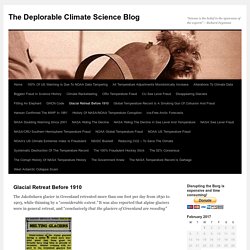
It was also reported that alpine glaciers were in general retreat, and “conclusively that the glaciers of Greenland are receding” 27 Jul 1903, Page 4 – at Newspapers.com Government climate experts say that the period of ice loss from 1850 to 1910 experienced global cooling, and was the coldest on record. National Geographic 1967 : Sunspots Control Glaciers.